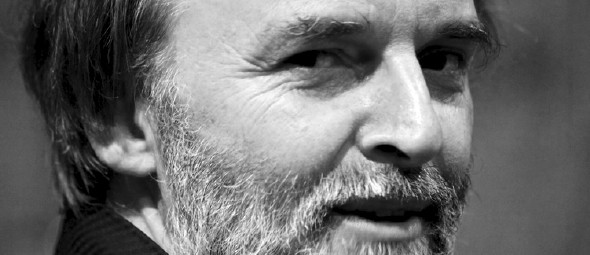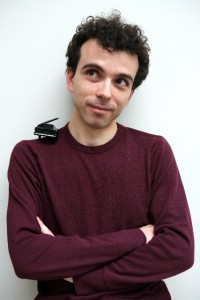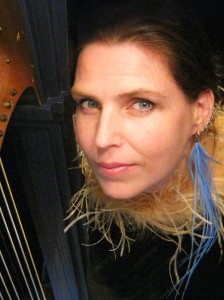Ariadne Rediviva
Ariadne Rediviva—Ariadne Retold—is a richly layered show combining live harp duo performance with poetic narration to recount the mythological life of Ariadne.
This timeless tale of human love, abandonment, and redemption has touched artists throughout history. The Atlantic Harp Duo has continued in this tradition by commissioning four pieces especially for this show, to go alongside a selection of works inspired by Ariadne’s story. Together with the composers old and new, the duo has crafted a soundscape that transports listeners into the fantastic world of Greek gods and heroes. Their original epic poem serves as the thread which leads listeners through the dreams and despair of our heroine, while two harps, one acoustic and one electric, carry the story through its crests and falls.
The story

Oh muses do tell us that age-old tale
of fair Ariadne, princess of Crete,
whose arduous love for great Theseus
mislead her to treachery and deceit.
The narration of the show takes the form of a masterly crafted, epic poem written in English by Marta Power Luce. It is a unique opportunity for audiences to experience the rich rhyme and meter of ancient oral tradition without needing to understand Greek or Latin. Breathing life into the written words, harpists Marta Power and Elizabeth Jaxon come out from behind their harps to share the tale in seamless flow with their musical performance.
The works we have commissioned
As part of this project, we have commissioned four original works for harp duo. This is an integral part of our general goal: to create and inspire quality works of music to add to the repertoire for two harps, which is currently relatively small when compared with other instrumental duos.
Minotaur by Stéphane Delplace
| Listen to a sample of the Minotaur |
The Minotaur, Ariadne’s half-brother, is a fantastical beast; half bull, half human, he is confined to the famous labyrinth, where he awaits his yearly feast of Athenian youths and maidens paid to Crete as a war bounty. We imagined this creature’s constant inner struggle with his two sides, beastly and human, to be much like that in the mind of someone suffering from an identity disorder. Minotaure is a work in three movements, which reflects this ever-changing character.
Stéphane Delplace is a French composer based in Paris. His works are a mix of J.S. Bach’s contrapuntal rigor and Brahms’ harmonic lyricism, and push the bounds of tonality.

“I do not believe that tonality has yet given us all that it holds… or that it ever will”.
Delplace is also professor of counterpoint and harmony at the École Normale de Musique de Paris and the Sorbonne University. During her time as his counterpoint student, Marta played his masterful harmonization of J.S. Bach’s violin partita no 2, which she transcribed for harp. Since then, she has hoped for just such an opportunity to commission a work for two harps from Delplace.
Naxos and the Journey with Dia by Roger W. Petersen
| Listen to a sample of Naxos |
This piece depicts the voyage of Ariadne and Theseus after Theseus defeated the Minotaur. The two lovers flee the Isle of Crete in the direction of Theseus’s native Athens. In the piece, we hear themes of love, but also a premonition of Ariadne’s abandonment on the Isle of Naxos after a great storm.

Roger W. Petersen’s compositions work with timber and sound quality of the instruments at hand.
“Generally, I get obsessed with sounds. It could be a triad or it could be the timbre of a harmonic. It could be anything. There are certain sounds that the harp creates that I just love, like the ringing quality of the instrument, especially in the lower register. I could listen to that forever. And the color and ringing of harmonics is just a wonderful sound.”
Roger W. Petersen (b. 1976) is currently an Assistant Professor of Composition and Theory at Del Mar College. Prior to his appointment at Del Mar College in Texas, in 2013, he spent two years teaching at Mahidol University in Bangkok, Thailand, where Elizabeth met him. Upon hearing his work performed there, she was impressed by his musical sensitivity and has been looking forward to inviting him to compose for the harp ever since.
www.rogerwoolworthpetersen.com
Bacchus by Damien Luce
| Listen to a sample of Bacchus |
After Ariadne’s abandonment on the Isle of Naxos, she is lost, woebegone and completely hopeless. Bacchus, the god of wine and ecstasy, discovers her, falls in love, and takes her to be his wife despite her mortal state. This joyful moment of redemption by such a jovial and mischievous god is a perfect place for the light and rhythmical piece Bacchus.

Damien Luce, French pianist, actor, and author has already written for the Atlantic Harp Duo. His Serenade for two harps was conceived as music for the show La Fontaine ou les animaux péstiférés, which played in two Parisian theaters in 2009.
“Writing for two harps creates an interesting opportunity for the use of bitonality and polyrhythm which is impossible on one harp. The antique connotations of the instrument will come together with this more contemporary harmonic treatment to create a piece that will fit in well with this program.”
Stellae Saltantem by Caroline Lizotte
| Listen to a sample of Stellae Saltantum |
Ariadne’s mortal life comes to an end while her husband Bacchus, an immortal god, lives on. To celebrate their love, he casts Ariadne’s nuptial crown into the sky where it becomes a constellation—the Crown of Ariadne, or Corona Borealis. We have entrusted this finale of Ariadne Rediviva to French Canadian harpist and composer Caroline Lizotte whose work we have greatly admired since discovering her duo Raga in 2009. In this piece, her innovative use of percussion instruments played by the two harpists as well as her colorful writing for the harps themselves made us want more!
“For this new opus, I am inspired by the duality found in mythology: mortals and gods, the terrestrial and the celestial. I feel I want to depict the archaic and the modern, mythology and astronomy as the ancients perceived it—the earth in a static sky. To bring out this duality, my duo will be composed of one acoustic and one electric harp, so that our two worlds, seemingly in opposition to each other, will meet.The Corona Borealis is a small constellation in the northern hemisphere that forms a half-circle and is made up of seven bright stars among which several are binary and double. Some rotate around each other in 17 days, some in 42 years, much like young and old couples dancing, doubtless Bacchus and Ariadne our even Ariadne and Theseus. Stellae Saltantem, meaning, “dancing stars” in Latin, is mortal Ariadne, loved by the gods, transported and immortalized in space. She is incarnated in music by the two harps, whose respectively different sounds, once united, will touch neither earth nor sky.”
The rest of the program
In addition to the four newly commissioned pieces, we will be playing three already existing works.
Ariadne Theseo by Franck Villard
One of our original sources of inspiration, Ariadne Rediviva pays tribute to this masterful work at the pivotal moment when Araidne laments her abandonment on the Isle of Naxos. In 2010, the Atlantic Harp Duo was invited to participate in the Villecroze Academy in southern France, where we met composer Franck Villard. Together with mezzo-soprano Sandrine Sutter, we had the immense pleasure of preparing and performing this piece. The trio is constructed much like a renaissance recitative in the style of Monteverdi—a declamatory vocal line with harmonic punctuation mixed with more lyrical passages. Though the structure is old, the harmonic language is thoroughly modern which gives this piece a remarkable dichotomy. The text of the vocal part is from Ovid, whose ideas now find their place within the narrative poem. Even in an excerpted version, Ariadne Theseo is the perfect piece to depict Ariadne’s sorrow and despair.
Épigraphes Antiques by Claude Debussy
This work in several short movements, originally for two harps, two flutes, and celesta, was written in 1914 to accompany a theatrical staging of the Chansons de Bilitis by Pierre Louÿs. This collection of erotic poetry from ancient Greece, apparently discovered and translated by Louÿs was nothing but a literary hoax, whose subsequent revelation only added to the notoriety of an already popular work.
In Ariadne Rediviva, excerpts from these musical images find their place again in a theatrical setting, as they serve to illustrate intermediary episodes of Ariadne’s life.
Labyrinth Dance by R. Murray Schafer
| Listen to a sample of the Labyrinth Dance |
The final movement of R. Murray Schafer’s Crown of Ariadne for solo harp, Labyrinth Dance, was originally intended as a duet between a live harp and a recorded harp. We have decided to perform both parts live with the recorded harp part on the electric harp. This piece, which uses many percussion instruments played by the harpists, depicts Theseus’s search for the Minotaur in the winding passages of the Labyrinth.






